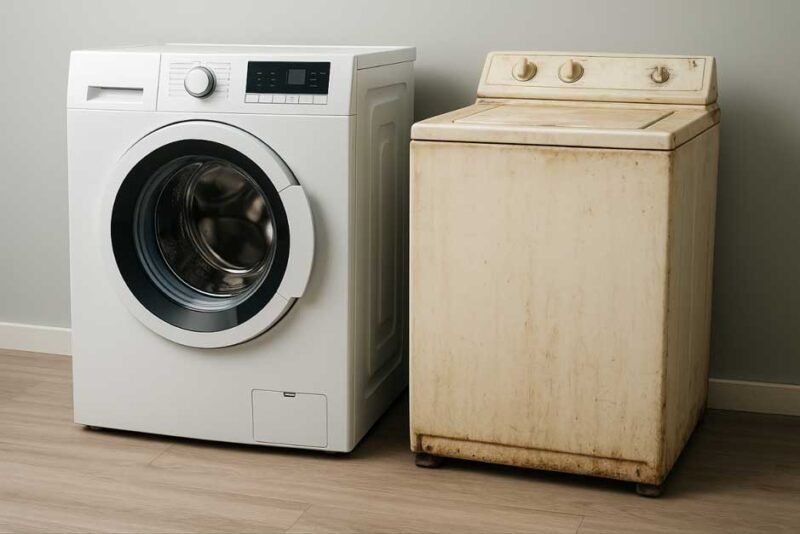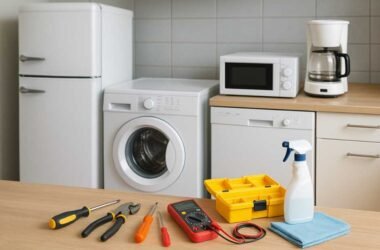Your washing machine is the unsung hero of laundry day. But when it starts making weird noises, leaking, or refusing to spin, you’re faced with a tough choice: fix it or toss it? That decision isn’t just about money — it affects your home routine, the environment, and your peace of mind. As someone who’s helped homeowners navigate this exact dilemma, often through Superior Appliances Repair, I understand how confusing it can be: shelling out cash for repairs or taking the plunge on a brand-new unit? This guide breaks it all down — lifespan, costs, hidden fees, repair frequency, parts availability, eco impact, maintenance tips, and when to call in the pros. Let’s untangle it together.
Understand Washing Machine Lifespan and Common Breakdowns
Washing machines typically last between eight and twelve years — but factors like heavy usage, hard water, or lack of upkeep can shorten that, notes RGroup Property Management Solutions. Common failures include motor burnout, drum seal leaks, worn bearings, electronic malfunctions, and pump issues. For example, if your washer is nearing ten years and you’ve replaced belts or bearings before, it’s likely approaching its twilight. On the flip side, a newer unit with a single broken part is worth fixing. Most manufacturers support parts for at least a decade, but after that? You’re on borrowed time. Understanding what’s normal versus symptomatic of a worn-out machine sets the tone for smart decision-making.
Age-Based Decision Factor
Let’s imagine your washer is nine years old. It still cleans clothes well, but changing belts or hoses feels like putting band-aids on a sinking ship. Many experts say once your machine hits 10–12 years, replacement tends to be more practical than repeated fixes. That’s because major components — like transmission units or sealed tub bearings — become harder to source or more expensive than the machine’s value. It’s simple math: if it’s older and nearing the end of its estimated lifespan, investing in a new one may be smarter than pouring cash into a fading machine.
Cost Comparison – Repair vs Replacement
Here’s where the numbers come in. Repairs range from $125 to $450, averaging $180 for common issues like belts, switches or valves. New washing machines start around $400 and can run past $1,000, depending on features or capacity. The “50% rule” is key: if a repair costs more than half the price of a new machine, you’re usually better off replacing. A $300 repair on a $600 washer? That’s the rubber-meets-the-road moment. Some homeowners report spending hundreds every few years — costs that quickly rival a brand-new machine’s price tag.
Hidden Costs and Long-Term Efficiency
But wait — there’s more to costs than repair fees. Older machines may guzzle more water and power, adding up in utility bills. Frequent service calls — diagnostics, tech visits, parts — also add time and stress. Compare that to a high-efficiency model that trims bills and works more quietly and reliably. Sometimes, investing in a new machine means saving over time — not just paying upfront.
Frequency of Past Repairs and Reliability Concerns
If you’ve patched your washer multiple times — belt in spring, motor in summer, pump in fall — that’s a pattern. Repeated breakdowns signal deeper wear in motor mounts, seals, or wiring. One-off issues? Fix them. But recurring hiccups suggest it’s time to let go. You’re not just buying fixes — you’re reinforcing confidence in a cleaner, hassle-free future without wondering what’ll go next.
Availability of Parts and Repair Complexity
Ever try finding parts for a decade-old washer? Good luck. Bearing assemblies, control boards, sealed drums — all might be out of stock or discontinued. Some front-load washers have bearings molded into the drum or sealed units that require expensive replacements. That’s planned obsolescence: some parts are essentially unrepairable. If parts aren’t available or cost nearly as much as a new machine, replacement often wins.
One Bullet List of Decision-Making Checklist
Here’s your all-in-one decision tool:
- Machine age (nearing 10–12 years?)
- Repair estimate vs new machine price (stick to the 50% rule)
- Usage frequency and past breakdowns
- Parts availability or obsolescence
- Energy and water efficiency comparison
- Time and inconvenience of repeated repairs
Use this as a cheat sheet once you get a repair quote and start weighing options.








